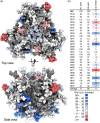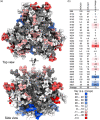Augmenting glycosylation-directed folding pathways enhances the fidelity of HIV Env immunogen production in plants
- PMID: 35781691
- PMCID: PMC9544252
- DOI: 10.1002/bit.28169
Augmenting glycosylation-directed folding pathways enhances the fidelity of HIV Env immunogen production in plants
Abstract
Heterologous glycoprotein production relies on host glycosylation-dependent folding. When the biosynthetic machinery differs from the usual expression host, there is scope to remodel the assembly pathway to enhance glycoprotein production. Here we explore the integration of chaperone coexpression with glyco-engineering to improve the production of a model HIV-1 envelope antigen. Calreticulin was coexpressed to support protein folding together with Leishmania major STT3D oligosaccharyltransferase, to improve glycan occupancy, RNA interference to suppress the formation of truncated glycans, and Nicotiana benthamiana plants lacking α1,3-fucosyltransferase and β1,2-xylosyltransferase was used as an expression host to prevent plant-specific complex N-glycans forming. This approach reduced the formation of undesired aggregates, which predominated in the absence of glyco-engineering. The resulting antigen also exhibited increased glycan occupancy, albeit to a slightly lower level than the equivalent mammalian cell-produced protein. The antigen was decorated almost exclusively with oligomannose glycans, which were less processed compared with the mammalian protein. Immunized rabbits developed comparable immune responses to the plant-produced and mammalian cell-derived antigens, including the induction of autologous neutralizing antibodies when the proteins were used to boost DNA and modified vaccinia Ankara virus-vectored vaccines. This study demonstrates that engineering glycosylation-directed folding offers a promising route to enhance the production of complex viral glycoproteins in plants.
Keywords: chaperones; glyco-engineering; glycosylation; immunogenicity; neutralization; occupancy; vaccine.
© 2022 The Authors. Biotechnology and Bioengineering published by Wiley Periodicals LLC.
Conflict of interest statement
Emmanuel Margolin, Ann Meyers, Ros Chapman, Anna‐Lise Williamson, Richard Strasser, and Edward P. Rybicki have filed patent applications describing approaches to produce recombinant glycoproteins in plants: WO 2018/069878 A1, WO 2018/220595 A1, PA174002/PCT, PA176498_P.
Figures







Similar articles
-
A plant-produced SARS-CoV-2 spike protein elicits heterologous immunity in hamsters.Front Plant Sci. 2023 Mar 7;14:1146234. doi: 10.3389/fpls.2023.1146234. eCollection 2023. Front Plant Sci. 2023. PMID: 36959936 Free PMC article.
-
The Glycan Hole Area of HIV-1 Envelope Trimers Contributes Prominently to the Induction of Autologous Neutralization.J Virol. 2022 Jan 12;96(1):e0155221. doi: 10.1128/JVI.01552-21. Epub 2021 Oct 20. J Virol. 2022. PMID: 34669426 Free PMC article.
-
A Roadmap for the Molecular Farming of Viral Glycoprotein Vaccines: Engineering Glycosylation and Glycosylation-Directed Folding.Front Plant Sci. 2020 Dec 3;11:609207. doi: 10.3389/fpls.2020.609207. eCollection 2020. Front Plant Sci. 2020. PMID: 33343609 Free PMC article. Review.
-
Closing and Opening Holes in the Glycan Shield of HIV-1 Envelope Glycoprotein SOSIP Trimers Can Redirect the Neutralizing Antibody Response to the Newly Unmasked Epitopes.J Virol. 2019 Feb 5;93(4):e01656-18. doi: 10.1128/JVI.01656-18. Print 2019 Feb 15. J Virol. 2019. PMID: 30487280 Free PMC article.
-
The HIV glycan shield as a target for broadly neutralizing antibodies.FEBS J. 2015 Dec;282(24):4679-91. doi: 10.1111/febs.13530. Epub 2015 Oct 23. FEBS J. 2015. PMID: 26411545 Free PMC article. Review.
Cited by
-
Prokaryote- and Eukaryote-Based Expression Systems: Advances in Post-Pandemic Viral Antigen Production for Vaccines.Int J Mol Sci. 2024 Nov 7;25(22):11979. doi: 10.3390/ijms252211979. Int J Mol Sci. 2024. PMID: 39596049 Free PMC article. Review.
-
Improved DNA Vaccine Delivery with Needle-Free Injection Systems.Vaccines (Basel). 2023 Jan 28;11(2):280. doi: 10.3390/vaccines11020280. Vaccines (Basel). 2023. PMID: 36851159 Free PMC article. Review.
-
A plant-produced SARS-CoV-2 spike protein elicits heterologous immunity in hamsters.Front Plant Sci. 2023 Mar 7;14:1146234. doi: 10.3389/fpls.2023.1146234. eCollection 2023. Front Plant Sci. 2023. PMID: 36959936 Free PMC article.
-
Heterologous Immunization with Improved HIV-1 Subtype C Vaccines Elicit Autologous Tier 2 Neutralizing Antibodies with Rapid Viral Replication Control After SHIV Challenge.Viruses. 2025 Feb 17;17(2):277. doi: 10.3390/v17020277. Viruses. 2025. PMID: 40007032 Free PMC article.
-
An oligosaccharyltransferase from Leishmania donovani increases the N-glycan occupancy on plant-produced IgG1.Front Plant Sci. 2023 Aug 8;14:1233666. doi: 10.3389/fpls.2023.1233666. eCollection 2023. Front Plant Sci. 2023. PMID: 37615026 Free PMC article.
References
-
- Behrens, A. J. , Harvey, D. J. , Milne, E. , Cupo, A. , Kumar, A. , Zitzmann, N. , Struwe, W. B. , Moore, J. P. , & Crispin, M. (2017). Molecular architecture of the cleavage‐dependent mannose patch on a soluble HIV‐1 envelope glycoprotein trimer. Journal of Virology , 91(2). 10.1128/JVI.01894-16 - DOI - PMC - PubMed
Publication types
MeSH terms
Substances
Grants and funding
LinkOut - more resources
Full Text Sources
Medical
Research Materials

